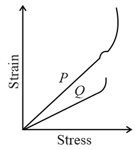EASY
Earn 100
Distinguish between elasticity and plasticity.
Important Questions on Properties of Solids and Liquids
EASY
Young’s moduli of the material of wires A and B are in the ratio of , while its area of cross sections are in the ratio of . If the same amount of load is applied to both the wires, the amount of elongation produced in the wires A and B will be in the ratio of [Assume length of wires A and B are same]
HARD
Calculate the strain energy per unit volume in a brass wire of length and area of cross-section when it is stretched by and a force of is applied to its free end.
MEDIUM
Two wires of the same material and length but cross sectional area in the ratio are used to suspend the same loads. The extension in them will be in the ratio
HARD
An external pressure is applied on a cube at so that it is equally compressed from all sides. is the bulk modulus of the material of the cube and is its coefficient of linear expansion. Suppose we want to bring the cube to its original size by heating. The temperature should be raised by:
EASY
A wire of diameter breaks under a tension of . Another wire of the same material as that of the first one, but of diameter breaks under a tension of:
MEDIUM
The Young's modulus of steel is twice that of brass. Two wires of same length and of same area of cross-section, one of steel and another of brass are suspended from the same roof. If we want the lower ends of the wires to be at the same level, then the weights added to the steel and brass wires must be in the ratio of:
EASY
Which one of the following is most elastic in nature?
MEDIUM
One end of a slack wire (Young's modulus, , length, and cross-sectional area, ) is clamped to a rigid wall and the other end to a block (mass ) which rests on a smooth horizontal plane. The block is set in motion with a speed, . What is the maximum distance the block will travel after the wire becomes taut?
HARD
A steel wire is suspended vertically from a rigid support. When the wire is loaded with a weight in air, it is extended by . When the weight is completely inside the water, the extension becomes . The relative density of the material of the weight is,
EASY
A fixed volume of iron is drawn into a wire of length . The extension produced in the wire by a constant force is proportional to _____.
MEDIUM
A metal rod of length and cross-sectional area is heated through . What is the force required to prevent the expansion of the rod lengthwise?
= Young's modulus of the material of rod, coefficient of linear expansion
MEDIUM
The elastic limit of brass is . The minimum diameter of a brass rod if it is to support a load without exceeding its elastic limit will be
MEDIUM
A steel rail of length and area of cross section is prevented from expanding along its length while the temperature rises by . If coefficient of linear expansion and Young's modulus of steel are and respectively, the force developed in the rail is approximately:
MEDIUM
A load of mass is suspended from a steel wire of length and radius in Searle's apparatus experiment. The increase in length produced in the wire is Now the load is fully immersed in a liquid of relative density The relative density of the material of load is The new value of increase in length of the steel wire is:
MEDIUM
The bulk modulus of a spherical object is . If it is subjected to uniform pressure , the fractional decrease in radius is
MEDIUM
A solid sphere of radius r made of a soft material of bulk modulus K is surrounded by a liquid in a cylindrical container. A massless piston of area floats on the surface of the liquid, covering entire cross-section of cylindrical container. When a mass m is placed on the surface of the piston to compress the liquid, the fractional decrement in the radius of the sphere , is:
EASY
In materials like aluminium and copper, the correct order of magnitude of various elastic modulii is :
EASY
Breaking stress of a steel wire is and the density of steel is . The greatest length of steel wire that can hang vertically without breaking is
HARD
In plotting stress versus strain curves for two materials and , a student by mistake puts strain on the -axis and stress on the - axis as shown in the figure. Then the correct statement(s) is(are)


